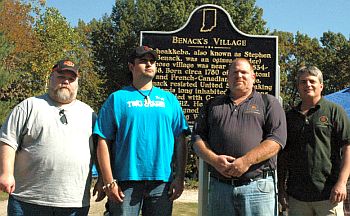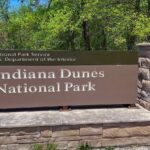 10/14/11 A historical marker, commemorating an important local Potawatomi leader, was dedicated Saturday October 8th at Potawatomi Wildlife Park. The marker honors Potawatomi village leader Stephen Benack and tells the story of the post-removal village that remained while other villages were forced west during the removal period of the 1830’s. The marker process was initiated in 2006 and three years of research and an additional year of drafts followed.
10/14/11 A historical marker, commemorating an important local Potawatomi leader, was dedicated Saturday October 8th at Potawatomi Wildlife Park. The marker honors Potawatomi village leader Stephen Benack and tells the story of the post-removal village that remained while other villages were forced west during the removal period of the 1830’s. The marker process was initiated in 2006 and three years of research and an additional year of drafts followed.
The dedication included a traditional blessing by Mike Zimmerman, Pokagon Band member, followed by a short review of Benack’s life and the history of the Potawatomi in the area by Dr. Ben Secunda. Secunda said the official policy of the U.S. government in the early 19th century was to push Indians out west. The fact that Benack got the right to stay here and resisted removal is why the historical marker is important. Whereas the other villages were on reservations, Benack bought title/patent to the property resulting in landowner rights that enabled him to thwart removal. Benack was the first to use this technique which was repeated by others in future years. Secunda is the Native American Graves Protection and Repatriation Act project manager for the University of Michigan.
Michael Stephan, Executive Director of the nonprofit park, commented “this marker is the Paul Harvey of markers”. While most local residents are familiar with the well told story of the removal period and the villages that were forced west, very few realize that the Benack Village remained afterward as an intact post-removal village.
The front of the sign reads: “Osheakkebe, also known as Stephen Benack, was an ogimaa (leader) whose village was near here, 1834-1848. Born circa 1780 of Potawatomi and French-Canadian heritage, Benack resisted United States’ taking of lands long inhabited by Indians and sided with Great Britain in War of 1812. He and allied Indian leaders signed 1815 peace treaty at Spring Wells near Detroit.”
The back of the sign reads: “Indian leaders traded tribal lands in Michigan, Indiana, Illinois and Wisconsin to U.S., 1817-1832, for annuities, reserves and land rights. By treaty, Benack secured 2,000 acres of land including his village, which remained despite U.S. forced removal of Indians from Indiana in 1830s and 1840s. Benack died in 1855 and was buried at the University of Notre Dame.”
About Potawatomi Wildlife Park: Potawatomi Wildlife Park is a free-admission 300-acre park along the Tippecanoe River south of Bourbon, IN. It is in Marshall County, just over the Kosciusko County border. Coming from the north, the park entrance is located approximately 1/2 mile south of State Road 10 directly across from 17th Road. Coming from the south, the entrance is approximately 1/2 mile north of the Tippecanoe Bridge on State Road 331.
Known for its Native American history, there are five miles of hiking trails, and many different habitats that are home to a variety of species. Endangered mussels as well as river otters are found in this section of the river as well.
The Park is open daily from sunrise to sunset for you to walk the trails and observe or study wildlife.
Photo by David Slone-Times Union














